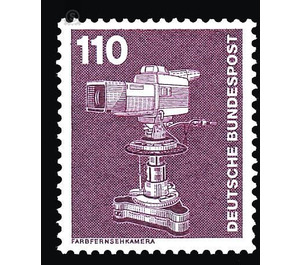Permanent series: industry and technology - Germany / Federal Republic of Germany 1982 - 110 Pfennig
Theme: Communication & Media
| Country | Germany / Federal Republic of Germany |
| Issue Date | 1982 |
| Face Value | 110.00 |
| Color | violet |
| Perforation | K 14 |
| Printing Type | Typography |
| Stamp Type | Postage stamp |
| Item Type | Stamp |
| Chronological Issue Number | 1007 |
| Chronological Chapter | GER-BRD |
| SID | 650571 |
| In 71 Wishlists | |
Supplementary values to the postage stamp continuous series »Industrie und Technik« introduced in 1975/76. The postage stamps appear at the same time and the same motif as the inscription "Deutsche Bundespost Berlin". The color camera converts the brightness, hue and color saturation of the image to be transmitted into electrical signals. It is based on the physical knowledge that each color can be represented by appropriate mixture of the three primary colors red, green and blue. The image to be transmitted is optically split into its three color components red, green and blue by means of a color divider via a lens. The color separations arrive at three image pickup tubes, on the photocathodes of which three charge images are generated, which are each scanned by an electron beam and converted into electrical signals. The history of color television begins with a patent issued in 1902 to O. Bronk. J. L. Baird and the Bell Company made practical experiments in 1928. The first experiments in Germany were undertaken by W. Bruch and O. von Bronk in 1936. In America, color television was introduced in 1954. From 1956 scientists in Europe dealt with this new technology. In 1963, W. Bruch introduced his Telefunken-developed PAL method (Phase Alternating Line). On 25 August 1967 on the radio exhibition in Berlin was the official beginning of the color television in the Federal Republic of Germany. (Text: Bayerischer Rundfunk, Munich)


